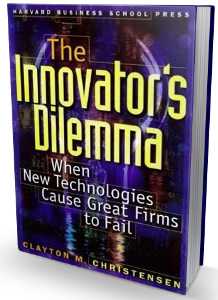The Innovator's Dilemma
 | |
| Author | Clayton Christensen |
|---|---|
| Country | United States |
| Language | English |
| Genre | Business theory |
| Publisher | Harvard Business Review Press; 1st edition (May 1, 1997) |
Publication date | 1997 |
| ISBN | 0875845851 |
| Followed by | ''The Innovator's Solution'' |
The Innovator's Dilemma: When New Technologies Cause Great Firms to Fail, generally referred to as The Innovator's Dilemma, is the most well-known work of the Harvard professor and businessman Clayton Christensen.
Subject matter
First published in 1997, Christensen's book suggests that successful companies can put too much emphasis on customers' current needs, and fail to adopt new technology or business models that will meet their customers' unstated or future needs. He argues that such companies will eventually fall behind. Christensen calls the anticipation of future needs "disruptive innovation," and gives examples involving the personal computer industry, milkshakes, and steel minimills.
As the title states, the innovator’s ‘dilemma’ comes from the idea that businesses or organizations will reject innovations based on the fact that customers cannot currently use them, thus allowing these ideas with great potential to go to waste. It goes into great detail the way in which ‘successful’ companies adhered to customer needs, adopted new technologies and took rivals into consideration, but still ended up losing dominance in their market.
The book's reception around the world suggests that it may help leaders of organizations see the problems or changes coming their way, whilst showing them how to respond.
Reception
Shortly after the release of the book, Christensen “received the Global Business Book Award for The Innovator’s Dilemma and The Economist named it as one of the six most important books about business ever written”.[1] It also received the Global Business Book Award as the best business book of the year (1997).[2]
Comments about the book
- “The Best Business Book of 1997 and The Best Business ‘How-To’ Book of 1997” --The Financial Times/Booz-Allen & Hamilton Global Business Book Awards[3]
- "This book addresses a tough problem that most successful companies will face eventually. It's lucid, analytical-and scary."—Dr. Andrew S. Grove, Chairman, Intel Corporation[4]
- "The "Innovator's Dilemma" is absolutely brilliant." Clayton Christensen provides an insightful analysis of changing technology and its importance to a company's future success. I highly recommend this book for anyone interested in business or entrepreneurship."—Michael R. Bloomberg, CEO and Founder, Bloomberg Financial Markets[5]
- "Managers reading Professor Christensen's book may come away with a heightened sense of paranoia. They will be none the worse for that. The idea of the disruptive technology is a simple and powerful one. There may be one lurking near you." -- "Financial Times"[6]
- "Christensen marshals so much data and analysis in support of his position that he makes a powerful case."—Context[7]
Criticism
One criticism of the book by Ben Thompson[8] is that the theory applies best to businesses with business customers. Thompson says that consumers are not as rational and single-minded as business customers, and hence are less susceptible to disruption. Thompson points to the iPhone as a consumer product that is not easily disrupted by a low-end disruption; Christensen maintains that the iPhone and Apple are good candidates for disruption.[9]
Impact on business world

The term disruptive technologies was first described in depth with this book by Christensen; but the term was later changed to ‘disruptive innovation’ in a later book (The Innovator's Solution). A disruptive innovation is an innovation that creates a new market and value network that will eventually disrupt an already existing market and replace an existing product.[10]
The Innovator's Dilemma proved popular; not only was it reprinted,[11] but a follow-on book entitled "The Innovator's Solution" was published.[12] His books "Disrupting Class"[13] about education and "The Innovator's Prescription"[14] about health care both utilize ideas from the Innovator's Dilemma.
References
- ↑ "Aiming high", Jun 30th 2011. http://www.economist.com/node/18894875
- ↑ Innosight,(2014). Clayton Christensen-Innosight Co-founder. [online] Available at: http://www.innosight.com/about-us/clayton-christensen.cfm [Accessed 15 Oct. 2014].
- ↑ Google Books, (2014). The Innovator's Dilemma. [online] Available at: http://books.google.co.uk/books/about/The_Innovator_s_Dilemma.html?id=SIexi_qgq2gC [Accessed 17 Oct. 2014].
- ↑ Ibid.
- ↑ Ibid.
- ↑ Ibid.
- ↑ Ibid.
- ↑ Thompson, Ben. "What Clayton Christensen Got Wrong". Stratechery. Retrieved 1 November 2014.
- ↑ Blodget, Henry. "Harvard Management Legend Clay Christensen Defends His 'Disruption' Theory, Explains The Only Way Apple Can Win". Business Insider. Retrieved 1 November 2014.
- ↑ Wikipedia, (2014). Disruptive innovation. [online] Available at: https://en.wikipedia.org/wiki/Disruptive_innovation#CITEREFChristensen2003 [Accessed 24 Oct. 2014].
- ↑ Christensen, Clayton (2011). The Innovator's Dilemma: The Revolutionary Book That Will Change the Way You Do Business. HarperBusiness. p. 336. ISBN 0062060244.
- ↑ Christensen, Clayton (2003). The Innovator's Solution: Creating and Sustaining Successful Growth. Harvard Business School Press. ISBN 1578518520.
- ↑ Christensen, Clayton; Johnson, Curtis; Horn, Michael (2010). Disrupting Class: How Disruptive Innovation Will Change the Way the World Learns (2 ed.). p. 272. ISBN 9780071749107.
- ↑ Christensen, Clayton; Grossman, Jerome H.; Hwang, Jason (2008). The Innovator's Prescription: A Disruptive Solution for Health Care. McGraw-Hill. p. 496. ISBN 9780071592086.
Further reading
- Jill Lepore, "What the Theory of 'Disruptive Innovation' Gets Wrong", The New Yorker, June 23, 2014.